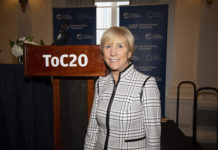By Jay D. Prince
So last month I waxed on and on about this grandiose idea for a squash club with 20 singles courts and four doubles courts that would be convertible between hardball and softball. Crazy, right? Maybe not.
Since I wrote about my little daydream, I’ve received several phone calls and emails about it. A couple from right here in Seattle and others from around the country. And it’s not like this sort of thing hasn’t been done before.
In Amsterdam, there is a club with 21 courts including a three-glass wall center court—about a mike from another club with 12 courts in a living room setting featuring a bar in the middle. That’s 33 courts within a mile of each other, both a which are packed five days a week.
I will be up front and admit that I have no experience managing a club…of any kind. None. Zilch. But it is really ludicrous to think something this big can’t work in the US? I know the cost would be huge; somewhere between $10-20 million. Fine. How many members would it take for a club like this to be economically viable? Better yet, if we assume squash alone couldn’t support a club of this size here, what else would it take to generate a sufficiently large membership base to make it work?
Basketball? Swimming? Aerobics? Yoga? Pilates? Spinning, cardio and weight rooms? A spa? How many personal trainers? A full-service restaurant or a cafe/bar? Parking and/or easy access to mass transportation like subways, light rail and busses? You tell me.
I’ve mentioned the Pro Sports Club that is located in proximity to Microsoft in Redmond, WA. That club is nearly 300,000 square feet with everything mentioned above plus six tennis courts. The Pro Club services somewhere in the neighborhood of 30,000 members. The Multnomah Athletic Club in Portland, OR, is similar in size with respect to membership.
With all the options outlined above, I would imagine a club like I’ve described would be able to accommodate a membership base that is similar in numbers. Obviously squash alone couldn’t support that. And I’m not so sure clubs of that size are really ideal. I’m sure they make a ton of money, but that isn’t really the point.
This idea is really about creating a destination for all things squash—and a very cool club for the locals in the area. If you think about it, even the US Championships struggle to find individual venues to host all matches during an event. True, Yale, Trinity and Harvard have a lot of courts. But even those facilities often need to rely on using local private schools for overflow.
When you stop and think about what the Urban Programs have accomplished in the last 10 years, it’s mind-boggling. The number of kids who have been given the opportunity to try this wonderful game is incredible. And most of those programs are working with just two schools in their areas. With the squash mecca, the potential for growth amount juniors is staggering. If you;re on the East Coast, you probably grew up with lacrosse as a staple of like for kids. That wasn’t the case on the West Coast. I had never heard of lacrosse until I saw it played at UC Berkeley. Today, lacrosse is spreading like wildfire now that the game has been exposed to schools. That’s really all it took, and it is rapidly catching up to soccer with respect to numbers of kids playing the game.
Kids everywhere are looking for fun things to do, not to mention their parents wanting that for them. Twenty singles courts (dare I say more?) would certainly make it possible to host kids from an entire city/region instead of just two schools. And this doesn’t even consider supporting an Urban Program at the same time.
Rather than rolling your eyes and brushing this concept aside, think about it for a while. Don’t get me wrong, I am not promoting this idea with the notion of wiping out small clubs. Far from it. There are lots of fantastic small clubs in this court. But there are undoubtedly areas where squash “Fields of Dreams” could thrive.





